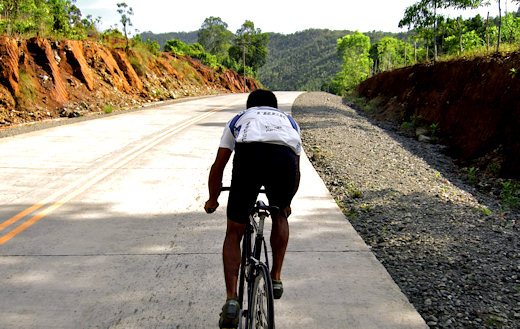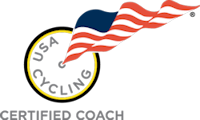
No matter what type of riding or racing you do, bike handling is of the utmost importance. Better bike handling means less chance of crashing. And therefore, more chance of winning races!
I suggest practicing your bike handling skills as often as possible. You can do this in your free time: it fits in on tough workout days as well as recovery days.
Here are seven drills you can do by yourself in an empty parking lot:
Table of Contents
1. The Slow Race
The slow race is simply riding between two points as slowly as possible without putting your foot down. The only rule is, you have to ride forward at all times – no zigzagging or hopping side to side. (Read my article about doing a track stand to get prepared, because you’ll be using track stands to slow yourself down.)
Doing this drill teaches you bike handling at slow speeds, getting you ready to tackle the rest of the drills.
Drill progression: Beginners can start out by doing the slow race on a slight incline to make it easier. Then you would progress to flat ground and eventually, a slight downhill.
2. The Heel Grab
For this drill, the goal is to grab onto one of your heels and keep riding along normally.
Start by pedaling normally, then lean to your left and use your left hand to grab onto your left heel. Continue to hold your heel as you pedal.
After a few pedal strokes, return your left hand to the handlebar. Then take your right hand and grab your right heel, holding onto it while pedaling.
The key to this drill is keeping your weight centered. Since your weight will be off to one side (whatever heel you are grabbing), you’ll have to lean the bike slightly in the opposite direction to stay balanced and on track.
Drill progression: You can start off holding your calf, then move to your ankle, then finally your heel. It gets harder, because the further down you reach, the more you must lean the bike to other side.
3. Bottle Pick Up
In this drill, you take a water bottle and set it on the ground, standing upright. Then you ride towards it so it is just off to your left. As you ride past the bottle, lean over and pick it up off the ground.
After pedaling a few strokes, lean over and set the bottle back on the ground carefully so it stays upright. This is the tougher part of the drill!
Then turn around and ride back towards the bottle; this time it should be just to your right because you will reach down and pick it up with your right hand. Then keep repeating the drill, switching hands each time.
This drill uses basically the same skill as the heel grab, e.g. as you lean down one way to grab the bottle, the bike needs to lean the other way. You won’t be pedaling though, so in this drill, you can lean even further over.
Drill progression: Beginners can start with the tall 32oz water bottles. Work you way to picking up a small 16oz bottle.
I also suggest filling the bottle at least half-way with water, which will help keep it stable.
4. The Slalom
Now we are getting into turning movements.
For this drill, you will create a slalom course using cones, tennis balls, or pebbles. You want to line up about six cones in a straight line, spaced about six feet apart.
Start by riding straight at the line of cones, and continue through the course by weaving around each cone. (You will ride to the left of the first cone, to the right of the second cone, to the left of the third cone, etc.)
The key here is to look straight ahead to the end of the course, but slalom your bike around the cones. Don’t stare at the cones.
Drill progression: Start with about 6-8 feet of space between the cones. Once you can handle that, move the cones closer together. Try it with just one bike length between cones.
5. The Offset Slalom
For the offset slalom, you use the same set-up as with the regular slalom. But this time, take every other cone and move it left or right 2-3 feet.
Now, instead of weaving around cones in a straight line, you have to take wider, sweeping turns.
To get through, you still look ahead to the finish, but you’ll have to lean a lot more to get around the cones.
6. Figure 8’s
Here’s the best turning drill of them all – figure 8’s.
The goal here is to ride your bike in a figure 8 within the smallest space possible. Ideally you will be able to do this within a single parking space (roughly a 10′ x 20′ rectangle). Of course, you have to do it without touching the lines or putting your foot down.
Remember the counter-balance technique you picked up in the heel grab drill? You’ll need to use that same idea when making such sharp turns. As you lean the bike into the turn, you put your weight on the outside. For example, if you’re making a sharp right turn, you should focus your weight on your left pedal.
The cool thing with figure 8’s is you can do them moderately fast in a small area, or if you do them really, really slow, you can them in a very small area.
7. Obstacle Hop
Lastly, the obstacle hop. This will prepare you for those times you face road obstacles such as pot holes or road kill. The obstacle in this case will be a piece of 2×4 lumber. (Or you could use a broomstick. Whatever you have handy.)
In Part A of this drill, you will ride over the 2×4 slowly, slightly unweighting each wheel. What this means is, as your front wheel reaches the 2×4, shift your weight so most of it is over the back wheel. Then once your front wheel is across, shift your weight forward over the front wheel so the back wheel can roll over the 2×4.
In Part B, you will still ride slowly, but you will fully unweight each wheel as it goes over the 2×4. As your front wheel approaches the 2×4, push down on your handlebars, weighting the front wheel. Just before touching the 2×4, straighten your arms and pull back with your body. This puts your weight over the back wheel and lifts the front wheel slightly, just enough to get it on top of the 2×4 and roll over it.
As your back wheel approaches the 2×4, shift your weight over the front wheel and use your feet to pull up and back on the pedals. This will bring the back wheel off the ground just enough to get it on top of the 2×4 and roll over smoothly.
For Part C, use the same technique as in Part B, but do it with more speed this time. You should be going fast enough that you have to unweight the back wheel immediately after the front wheel crosses the 2×4.
Part D is where is gets tougher. This time, you have to ride even faster at the 2×4, because you are going to stay centered and unweight the entire bike so that you can hop over the 2×4 with one jump. The principle is the same though.
As you ride toward the 2×4, crouch down, putting weight on both the handlebar and the pedals (effectively weighting both wheels). Right before you hit the 2×4, spring up into the air. You’ll use the same pulling motions as last time (pull up on bar and up on pedals), but use both at the same time.
Personally, I think this skill training is loads of fun. But even if you don’t, I think you’ll agree it’s worthwhile once you see how much your bike handling skills improve!
This article was originally published on September 21, 2011. It was updated and republished on July 1, 2018.
Levi Bloom is an experienced endurance athlete who has been training and competing for over 17 years. A former Cat 1 road and mountain bike racer (professional class on the regional circuit), he is now a cycling coach (USA Cycling Level 3 Certified) and sports nutrition coach (Precision Nutrition Level 1 Certified).









This is good info havnt rode in a while thanks.
@Ronna
Working on these drills will help you gauge where you are and help you get ready, quickly. Have fun out there!